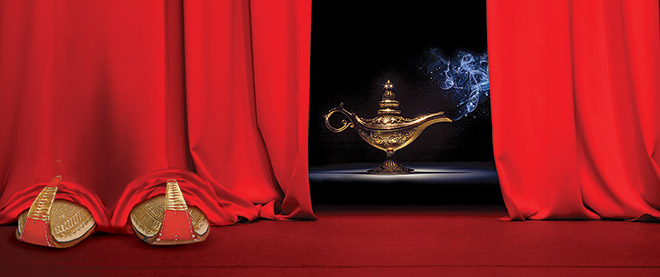The challenge of resurrecting Aladdin
Fez, check. Sword-dance, check
Photo illustration by Sarah MacKinnon
Share

It’s an understatement to say that the Walt Disney film Aladdin was never very popular with Middle Eastern and Arab advocacy groups. Jack Shaheen, author of Reel Bad Arabs: How Hollywood Vilifies a People, still remembers leading the campaign against “the bucktoothed guards, the belly dancers, every stereotype from the past,” and objecting in particular to a scene where the heroine almost gets her hand cut off for stealing. But Disney has turned the 1992 film into a lavish musical. Currently playing at the Mirvish Theatre in Toronto in preparation for a planned Broadway opening, Aladdin: The New Musical uses the same basic plot as the original, and is likely to spark more controversy about its new songs than any cultural issues. With Pocahontas or Mulan, there may be worries about cultural sensitivity, but with the Arabian Nights, the beloved stories that gave us not only Aladdin but also Sindbad the Sailor and Ali Baba, the company can present the wild mixture of Middle Eastern folk tales and pop culture that Broadway and Hollywood have offered for 100 years.
In mashing together the One Thousand and One Nights with American humour, and casting white actors as some of the Middle Eastern characters, Aladdin the musical is relying on this old formula. It’s been strongest in animation, where Popeye and Bugs Bunny have met the likes of Sindbad. “Flying carpets, fantastic voyages, magic genies in bottles . . . How could that not appeal as a backdrop for guys making films with talking rabbits and ducks?” says animation historian Thad Komorowski, author of Sick Little Monkeys: The Unauthorized Ren & Stimpy Story. But it’s also popped up in movies such as The Thief of Baghdad and the Broadway musical Kismet, which held the record for the most harem dancers onstage until Aladdin came along.
Disney’s Aladdin is full of deliberately anachronistic jokes, with the stage show reinventing the genie as a wisecracking jazzman who talks to the audience and makes TV show references. This makes it similar to Kismet, which takes place in Baghdad but uses Russian music for its songs, or Bugs Bunny’s A-Lad-In His Lamp, where the genie has a bathtub in his lamp. Michael Barrier, author of Walt Disney: The Animated Man, says the gags “are built from half-remembered scraps with minimal reference to anything real. Those guys probably saw The Sheik when they were kids.”
Some have found this tradition insentitive. Shaheen, who has consulted on Syriana and Three Kings, had some success in 1992 when he and other activists lobbied Disney to change the lyric “where they cut off your nose where they don’t like your face” in the first song of Aladdin, a line that was cut from the movie and remains unused in the stage production.
“It wasn’t easy,” Shaheen recalls. “And they didn’t change anything else, and then they came out with these TV movies where the stereotypes were every bit as damaging. The good news was that, as a result of our meetings, a Disney spokesperson did say they were more sensitive to Native Americans in Pocahontas.” He’s still annoyed that no one has contacted him about the stage show: “They consulted with Native Americans with Pocahontas, with Asians with Mulan—why haven’t they consulted with us?”
But though the tropes of Hollywood Arabian Nights are present, such as Aladdin’s trademark fez and a show-stopping sword dance, Disney might not have to worry as much over Aladdin. Unlike the Disney caricatures that have caused trouble, such as the Native Americans in Peter Pan, Aladdin is so far removed from the real Middle East that it doesn’t seem to be making any point at all about it.
That would put Aladdin in a long tradition of cartoons and live-action productions that, as Komorowski phrases it in discussing Popeye’s version of Ali Baba, “sidestep the issue of racial imagery altogether and focus on the grandeur of the locale and inherent fantasy.” Barrier points to a gag from the cartoon Porky in Egypt, where a character seems to be about to pray but instead rolls dice. “Is that gag disrespectful, or even sacrilegious? I’m not sure,” Barrier says, but, “I doubt that Warner Bros. got any complaints.”